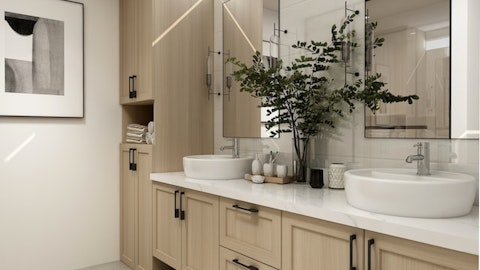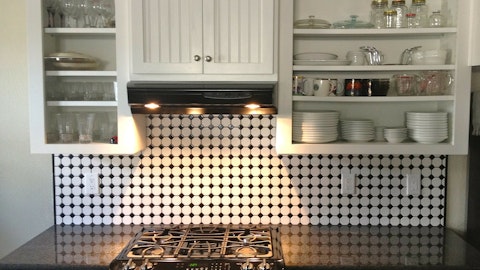American Woodmark Corporation (NASDAQ:AMWD) Q2 2024 Earnings Call Transcript November 30, 2023
American Woodmark Corporation beats earnings expectations. Reported EPS is $2.36, expectations were $1.84.
Operator: Good day, everyone, and welcome to the American Woodmark Corporation Second Fiscal Quarter 2024 Conference Call. Today’s call is being recorded, November 30, 2023. During this call, the company may discuss certain non-GAAP financial measures included in our earnings release, such as adjusted net income, adjusted EBITDA and adjusted EBITDA margin, free cash flow, net leverage, and adjusted EPS per diluted share. The earnings release, which can be found on our website, americanwoodmark.com, includes definitions of each of these non-GAAP financial measures, the company’s rationale for their usage, and a reconciliation of these non-GAAP financial measures to the most comparable GAAP financial measures. We also use our website to publish other information that may be important to investors, such as investor presentations.
We’ll begin the call by reading the company’s safe harbor statement under the Private Securities Litigation Reform Act of 1995. All forward-looking statements made by the company involving material risks and uncertainties and are subject to change based on factors that may be beyond the company’s control. Accordingly, the company’s future performance and financial results may differ materially from those expressed or implied under any under any such forward-looking statements. Such factors include, but are not limited to, those described in the company’s filings with the Securities and Exchange Commission and the annual report to shareholders. The company does not undertake to publicly update or revise its forward-looking statements, even if experience or future changes make it clear that any projected results expressed or implied therein will not be realized.
I’d now like to turn the floor over to Paul Joachimczyk, Senior Vice President and CFO. Please go ahead, sir.
Paul Joachimczyk: Good afternoon, and welcome to American Woodmark’s Second Fiscal Quarter Conference Call. Thank you all for taking the time today to participate. Joining me is Scott Culbreth, President and CEO. Scott will begin with a review of the quarter, and I’ll add additional details regarding our financial performance. After our comments, we’ll be happy to answer questions.
Scott Culbreth: Thank you, Paul, and thanks to everyone for joining us today for our second fiscal quarter earnings call. Our team delivered net sales of $473.9 million, representing a decline of 15.6% versus the prior year. Within new construction, our business declined 11.1% versus prior year. Macroeconomic factors, including interest rates and housing affordability continues to account for the slowdown in new construction. These short-term factors are being partially mitigated by builders through rate buydowns and shifts to ready to move in homes and build to rent homes. We are strategically aligned with top19 of the top 20 national builders and key regional builders. With our best-in-class direct service model, we plan to continue to grow our share with new and existing customers and take advantage of the share gains our partners are realizing in the marketplace.
Looking at remodel, which includes our home center and independent dealer and distributor businesses, Revenue declined 18.8% versus the prior year. Within this, our home center business was down 18.3% versus the prior year. Demand trends declined due to lower in-store traffic rates and consumers choosing smaller-sized projects. With regards to our dealer, distributor business, we were down 20% versus the prior year. Our adjusted EBITDA increased 7% to $72.3 million or 15.3% for the quarter. Reported EPS was $1.85 and adjusted EPS was $2.36. The improvement in performance is due to product mix and improved efficiencies in the manufacturing platforms. Our team continues to drive operational excellence in our plans. Our cash balance was $96.4 million at the end of the second fiscal quarter, and the company has access to an additional $323.2 million under its revolving credit facility.
Leverage was reduced to 1.05 times adjusted EBITDA, and the company repurchased 394,000 shares in the quarter. Our Board has authorized a new $125 million share repurchase program that replaces our current authorization that only had $22.9 million remaining. Our outlook for fiscal year ’24 remains unchanged, and with our expectations for sales of a low double-digit decline. Due to the strong fiscal second quarter performance, our adjusted EBITDA expectation is increasing to a range of $235 million to $250 million. Our team continues to execute against our strategy that has three main pillars: growth, digital transformation, and platform design. Growth will benefit from an upcoming launch of a low SKU, high-value offering in the home centers targeting PROs and a new brand to serve our distribution customers.
Digital transformation efforts over the last fiscal quarter include the final planning of ERP for Monterrey Go Live next quarter and website enhancements for our home center business to the launch in February. In addition, we completed the implementation of our CRM sales solution across the new construction channels field sales organization, and we initiated the planning for the next phase of work, which includes the CRM service module supporting our customer care organization and new construction service center operations. Platform design work continues with occupancy in monitoring Mexico in November and Hamlet, North Carolina in December. We will continue infrastructure and equipment installations in the coming months as well as training and hiring new teammates to support the initial ramp plan.

As a reminder, this expansion will deliver additional capacity in our stock kitchen and bath cabinetry product lines. In closing, I am proud of what this team accomplished in the second fiscal quarter and look forward to their continuing contributions during fiscal year ’24. I’ll now turn the call back over to Paul for additional details on our financial results for the quarter.
Paul Joachimczyk : Thank you, Scott. Reviewing our second quarter results for fiscal year 2024. Net sales were $473.9 million, representing a decrease of $87.6 million or 15.6% versus the prior year. Remodel net sales, which combines home centers and independent dealers and distributors decreased 18.8% for the second quarter versus prior year. With both home centers and dealer distributors decreasing 18.3% 20%, respectively. New construction net sales decreased 11.1% for the quarter compared to last year. Our gross profit margin for the second quarter fiscal year 2024 improved 420 basis points to 21.8% of net sales versus 17.6% reported in the same period last year. Gross margin benefited from a favorable product mix and sustained pricing matching inflationary cost impacts, continued operational improvements in our manufacturing facilities, and an increased stability in our supply chain.
Total operating expenses, excluding any real restructuring charges for the second quarter of fiscal year 2024 was 12.2% of net sales versus 10.1% for the same period last year. The 210-basis point increase is due to increases in our incentives and profit sharing for all employees. Adjusted net income was $38.8 million or $2.36 per diluted share in the second quarter of fiscal year 2024 versus $37.3 million or $2.24 per diluted share last year. Adjusted EBITDA for the second quarter of fiscal year 2024 was $72.3 million or 15.3% of net sales versus $67.6 million or 12% of net sales reported in the same period last year. This represents a 330-basis point improvement year-over-year. Despite facing the year-to-date volume headwinds, our continued strong earnings performance this year is a direct result of the hard work and efforts our teams have put in to reestablish our operating efficiencies, stabilize our supply chain, and controlled spending in the SG&A functions.
These earnings gains are partially offset by increases in incentive compensation, profit sharing, and our digital transformation costs. Free cash flow totaled a positive $109.9 million for the current fiscal year-to-date compared to $44.4 million in the prior year. The $65.4 million increase was primarily due to changes in our operating cash flows specifically higher net income and lower inventory, partially offset by our increased capital expenditures. Net leverage was 1.05 times adjusted EBITDA at the end of the second quarter fiscal year 2024, representing a 1.18 times improvement from the 2.23 times as of last year. As of October 31, 2023, the company had $96.4 million of cash and cash equivalents on hand, plus access to $323.2 million of additional availability under our revolving facility.
Under the current share repurchase program, the company purchased $30 million or 394,000 shares in the second quarter, representing about 2% of the outstanding shares being retired. The Board of Directors has approved and authorized a new $125 million share repurchase plan. We are retiring the remaining $22.9 million on the old share repurchase authorization and rolling it into this new authorization. Our outlook for fiscal year 2024 remains unchanged from a sales perspective, and we continue to expect low double-digit declines in net sales versus fiscal year 2023. The change in net sales is highly dependent upon overall industry economic growth trends, material constraints, labor impact, interest rates, and consumer behaviors. Given our strong performance for the first half of the year, we are increasing our adjusted EBITDA expectation for the full fiscal year 2024 to a range of $235 million to $250 million.
increase in our expected outlook is due to our strong operational performance and execution we have achieved in the first half of our fiscal year 2024. Reiterating our outlook from the past quarter, we are still on track for starting our new operational locations in Hamlet, North Carolina, and Monterrey, Mexico this fiscal year. This will negatively impact the results as we continue incurring the operational expenses without the offsetting full revenue performance of those locations. The total impact of these charges is approximately $8 million in the full fiscal year 2024. Our capital allocation priorities for fiscal year 2024 remain unchanged. We will first be focused on investing back into the business for the plant expansions in Monterrey, Mexico and Hamlet, North Carolina, continuing our path forward in our digital transformation with investments in our ERP and CRM solutions, and investing in automation.
Next, we will continue our share repurchasing. And given our current position, we will be deprioritizing paying down debt in fiscal year 2024. In closing, the business continues to build off the progress made throughout the past year. We fully expect these improvements to carry through the financials for the remainder of the fiscal year. This is a testament to the commitment, hard work, and efforts our employees invest in the company to achieve our results and the direct alignment to the GDP strategy. I’m grateful for what the teams have accomplished and thank all of our team members at American Woodmark for their continued efforts. They are the ones who truly make it happen daily. This concludes our prepared remarks. We’ll be happy to answer any questions you have at this time.
Operator: Ladies and gentlemen, at this time, we’ll begin the question-and-answer session. [Operator Instructions]. Our first question today comes from Garik Shmois from Loop Capital. Please go ahead with your question.
See also 20 States with Highest Minimum Wage and Low Cost of Living and 12 Countries That Consume the Most Salt.
Q&A Session
Follow American Woodmark Corp (NASDAQ:AMWD)
Follow American Woodmark Corp (NASDAQ:AMWD)
Garik Shmois : Congrats on the quarter. Within R&R, I was wondering if you could go into some more color on what you were seeing on both in-stock and made-to-order categories.
Scott Culbreth: Yes. Thanks, Garik. So specifically, in R&R at the home center side, when you talk about in-stock and MTO, we’ve seen negative trends in both categories, but MTO has been more severely impacted overall — when you think about the price points. We’ve always said that we felt the stock category would be a bit more resilient in a slowdown. But even in this environment today, we are seeing unfavorable trends, but not to the degree we see in special order.
Garik Shmois : Got it. I think you spoke to a favorable mix. I think that was more related to R&R, but I think we were hearing from a competitor that they were seeing trade-down effects more on the new construction side, Curious to see if you were seeing the same negative trade-down pressures and just maybe speak to pricing trends more broadly.
Scott Culbreth: So yes, we’re not seeing that same trend. We’ve also not got the high end of the price continuum, so we’re not selling custom or high-end semi-custom products to trade down against in the value space that we’ve been, we’ve seen very much a maintenance mode and some positive mix depending on the customer and the product category.
Operator: Our next question comes from Steven Ramsey from Thompson Research Group. Please go ahead with your question.
Steven Ramsey: Good evening. Maybe to start with on the raised EBITDA guidance a very strong first half. Can you clarify if any of that is the second half outlook being any better?
Paul Joachimczyk: I guess, Stephen, I guess, maybe rephrase your question about the second-half outlook being better.
Steven Ramsey: Sure. On the EBITDA guidance being raised, was that solely in the first half? Or does the second half of the year have anything to do with that?
Paul Joachimczyk: Yes, it’s primarily the first half performance that we’ve seen because there’s still so much uncertainty as we think about the second half from a demand profile standpoint. And as we’ve signaled over the past couple of quarters, we do have those start-up costs that Paul referenced of roughly $8 million that’s all back half loaded for Monrad Hamlet.
Steven Ramsey: Okay. Helpful. And then if you think about stocking levels by channel and customer type, do you feel that they’re at a healthy level? Or do you think given the slowdown broadly the big ticket, do you think that some customer channel partners have taken stock down too low?
Scott Culbreth: So yes, just as a reminder, the vast majority of our portfolio was not stocked at a retailer or at a builder or at a dealer. So, you really are only talking about our stock kitchen and bath business that sits inside the home centers. Now over the last couple of quarters, we’ve had some discussion around some destocking that had occurred that was impacting the business. I feel we’re roughly behind that. There’s always some opportunities to get better in-store positions, and we continue to pursue those with the retailers, but nothing of significance that I would highlight in that space.
Steven Ramsey: Okay, helpful. Thank you.
Operator: And our next question comes from McClain Hayes from Zelman & Associates. Please go ahead with your question.
McClain Hayes : Was curious if you could talk a little bit about input costs and how they’re trending at this point?
Scott Culbreth: Yes, certainly. When you think about the raw materials that we’re purchasing, those have stabilized. So that’s a positive. On the flip side, we do continue to see upward pressure in the labor markets as well as domestic transportation.
McClain Hayes : And has any of that relief, I guess, on the hardwood lumber side, heard a discussion around pricing rollbacks across any of your three channels?
Scott Culbreth: I certainly wouldn’t use the term rollbacks when we talk about pricing. We do monitor those input costs, and we do have some arrangements that are tied to those particular indices. But our general philosophy and approach and discussion that we’ve shared even in this call over the last couple of quarters is that any pricing reductions would have to be driven by deflation first. But also, there being an evaluation of the profitability of that particular channel and customer because we’ve got to continue to deliver on our long-term profitability goals. So, I’ll just say that we’re always having conversations around price and has continued to be ongoing with our customers.
McClain Hayes : Okay. And I guess one last one. Could you just elaborate a bit on some of those website changes you alluded to in the home center channel?
Scott Culbreth: Yes. It’s basically just a reskin and a refresh. More relevant content as well as ways to drive consumers through the purchase journey that ultimately helps drive them into the store. — to ultimately make a purchase decision.
Operator: Our next question comes from Julio Romero from Sidoti & Company. Please go ahead with your question.
Julio Romero: Can you maybe just dig a little bit more into the operational efficiencies and the stabilization of the supply chain? And how much more runway do you have for each of those?
Scott Culbreth: I think on the supply chain stability, that’s pretty much secured and we kind of lapped that. So, we’ve had a couple of quarters of that performance being very strong. So, we’re not seeing the disruptions that we were experiencing over the last couple of years. I would say that we always have ongoing opportunity in the operations side. We talk about operational excellence across the business, not just in the manufacturing facilities, but all of our functional costs’ areas, and we’ll continue to drive projects to take cost out of those particular areas as we go forward.





